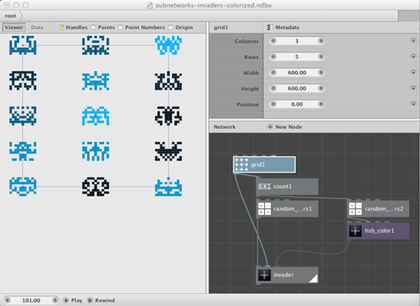
Hover over the seed port of the pick1 node. This means we’re in the invader subnetwork. Note that in the top part of the window, it says “root > invader”. Right click the invader node and choose “Edit Children”. To make ports available to the upper level, we publish them. We can’t change the seed like we did before, for example. Note that the invader node doesn’t take any inputs. You can now choose a name for your subnetwork, type invader. Right-click one of them and choose “group into network”:.  Select all nodes (grid1, pick1, rect1, reflect1) by dragging over them. To make more of them, we will group the invader nodes into their own network, much like the built-in nodes of NodeBox. We’ve just created one space invader character. You can create different variations of the invader by changing the seed value of pick1. Connect the output of rect1 to the shape port of reflect1. Create a reflect node and set angle to 90.00. Connect the output of pick1 to the position port of rect1. Create a rect node and set width and height to 10.00. Connect the output of grid1 to the list port of pick1. Create a pick node and set amount to 25. Instead we’re going to pick some random points to work with.
Select all nodes (grid1, pick1, rect1, reflect1) by dragging over them. To make more of them, we will group the invader nodes into their own network, much like the built-in nodes of NodeBox. We’ve just created one space invader character. You can create different variations of the invader by changing the seed value of pick1. Connect the output of rect1 to the shape port of reflect1. Create a reflect node and set angle to 90.00. Connect the output of pick1 to the position port of rect1. Create a rect node and set width and height to 10.00. Connect the output of grid1 to the list port of pick1. Create a pick node and set amount to 25. Instead we’re going to pick some random points to work with. #Nodebox network data full#
If we would put rectangles on all these points we’d just get a full block.Set columns to 6, rows to 8, width to 50.00 and height to 70.00.We’re going to create one half of the space invader, then reflect it across the X axis. The space invader character is a symmetrical grid of 11 x 8 points.
 Group all nodes related to the character in a network and give it a name. First, design one character in the root network. Click the segment in the address bar at the top of the NodeBox window:Īs an example of a custom node we’re going to create the classic “space invaders” character using NodeBox. To go down into a network, right-click the node and select Edit Children. For example, a network for an animated character could look like this: At the root, or base, of this tree is the root node. Like directories on your hard drive, NodeBox files are organized as a tree. NodeBox networks can also act as custom nodes, much in the same way as the built-in nodes. For example, when working on a data visualisation project, the header and explanatory text could go in a subnetwork “captions”. By grouping a block of nodes into a network, you can box up and name a group of functionality. NodeBox networks can act as an organizational tool, keeping big networks tidy.
Group all nodes related to the character in a network and give it a name. First, design one character in the root network. Click the segment in the address bar at the top of the NodeBox window:Īs an example of a custom node we’re going to create the classic “space invaders” character using NodeBox. To go down into a network, right-click the node and select Edit Children. For example, a network for an animated character could look like this: At the root, or base, of this tree is the root node. Like directories on your hard drive, NodeBox files are organized as a tree. NodeBox networks can also act as custom nodes, much in the same way as the built-in nodes. For example, when working on a data visualisation project, the header and explanatory text could go in a subnetwork “captions”. By grouping a block of nodes into a network, you can box up and name a group of functionality. NodeBox networks can act as an organizational tool, keeping big networks tidy. 
This works just like on your computer, where you can group related files in a directory on your hard disk. To solve this, NodeBox can group related nodes into a network. After a while, it becomes harder and harder to find the node you’re looking for.







 0 kommentar(er)
0 kommentar(er)
